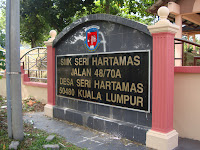 On January 18 the Hope Project Interns went to Sekolah Menengah Kebangsaan Sri Hartmas for our first HIV/AIDS workshop.We had prepared slides in Powerpoint and also on cardboard, with the expectation that around 50 students would be in the audience. Games had been prepared to get every student actively involved in the learning process. These included an ice-breaking game, and some games throughout the presentation to reinforce the message.
On January 18 the Hope Project Interns went to Sekolah Menengah Kebangsaan Sri Hartmas for our first HIV/AIDS workshop.We had prepared slides in Powerpoint and also on cardboard, with the expectation that around 50 students would be in the audience. Games had been prepared to get every student actively involved in the learning process. These included an ice-breaking game, and some games throughout the presentation to reinforce the message. We were informed on the evening of 17 January that in fact around 200 students would be present for one workshop. This meant that the workshop would be less interactive than we had hoped. We therefore eliminated the ice-breaking game, since it involved self-introductions and running around by the audience.
Once the microphone was working, things went well for the first 10 minutes of the presentation. However, after this, a large group of late students entered the room. This disrupted the session, and also meant that there were a large number of people now in the audience who had not heard some important messages at the beginning of the presentation. From this point, we had some trouble controlling noise in the room.
For the high-risk/low-risk game, we chose two groups of 10 (one group of boys ad one group of girls) to compete against each other for points at the front of the hall. Involving everyone in the game was impossible given the numbers. This game went alright, as we explained each answer at the end.
In order to involve the entire audience as much as possible in the “true-false”game, we used candies as an incentive to get members of the audience to raise their hands and answer questions. This worked ok, as there were a number of students who were quite enthusiastic. However there were also many students who did not participate. This dynamic however would be common amongst any group of 14 year-olds.
At the end, we rounded off the presentation by getting students to ask any questions they had. There were a number of good questions. We then quickly introduced each of our countries.
The feedback we received from AIESEC LC members who observed the workshop, was that we sometimes talked too fast, or with too much of a strong accent. We decide to take extra care with this issue at the next workshop. Audibility would also have been hindered by the persistent murmuring of students at the back of the hall.
Overall, considering our surprise at having to present for 200 people, the workshop went well, and boosted our confidence for future sessions. Although it was not as interactive as we had hoped, we believe most students learnt at least something about HIV/AIDS by the end of the session.














